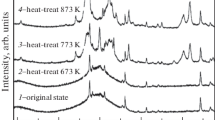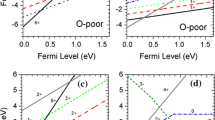Abstract
Tin-doped In2O3 layers were prepared by the spray technique with doping concentrationsc Sn between 1 and 20 at. % and annealed at 500 °C in gas atmospheres of varying oxygen partial pressures. The room-temperature electrical properties were measured. Maximum carrier concentrationsN=1.5×1021cm−3 and minimum resistivities ϱ=1.3×10−4 Ω cm are obtained if the layers are doped withc Sn≈9 at. % and annealed in an atmosphere of oxygen partial pressurep O2 ⋦10−20 bar. At fixed doping concentration, the carrier mobility increases with decreasing oxygen pressure. The maximum obtainable mobility can be described in terms of electron scattering by ionized impurities. From an analysis of the carrier concentration and additional precision measurements of the lattice constants and film thicknesses, a defect model for In2O3:Sn is developed. This comprises two kinds of interstitial oxygen, one of which is loosely bound to tin, the other forming a strongly bound Sn2O4 complex. At low doping concentrationc Sn≲4 at. % the carrier concentration is governed by the loosely bound tin-oxygen defects which decompose if the oxygen partial pressure is low. The carrier concentration follows from a relationN=K 1 ·p O2 −1/8 ·(3 ×1010 × cSn −N)1/4 with an equilibrium constantK 1=1.4×1015 cm−9/4bar1/8, determined from our measurements.
Similar content being viewed by others
References
D.B.Frazer: Proc. IEEE61, 1013–1018 (1973)
R.R.Mehta, S.F.Vogel: J. Electochem. Soc.119, 752–756 (1972)
J.B.DuBow, D.E.Burk: Appl. Phys. Lett.29, 494–496 (1976)
H.J.J. van Boort, R.Groth: Philips Techn. Rev.29, 17–18 (1968)
J.C.C.Fan, F.J.Bachner: Appl. Opt.15, 1012–1017 (1976)
S.Yoshida: Appl. Opt.17, 145–150 (1978)
H.K östlin: Philips Techn. Rev.34, 242–243 (1974)
J.A.Thornton, V.L.Hedgcoth: J. Vac. Sci. Technol.13, 117–121 (1976)
H.W.Lehmann, R.Widmer: Thin Solid Films27, 359–368 (1975)
D.B.Frazer, H.D.Cook: J. Electrochem. Soc.119, 1368–1374 (1972)
J.C.C.Fan, F.J.Bachner: J. Electrochem. Soc.122, 1719–1725 (1975)
P.Nath, R.F.Bunshah: Thin Solid Films69, 63–68 (1980)
J.Kane, H.P.Schweizer, W.Kern: Thin Solid Films29, 155–163 (1975)
D.K.Ranadive, F.T.J.Smith, R.P.Khosla: Proc. 6th Intern. Conf. Chemical Vapor Deposition 1977 (The Electrochem. Soc. 1978) pp. 448–460
R.Groth: Phys. stat. sol.14, 69–75 (1966)
A.Raza, O.P.Agnihotri, B.K.Gupta: J.Phys. D (Appl. Phys.)10, 1871–1876 (1977)
J.C.Manifacier, M.de Murcia, U.P.Fillard: Mater. Res. Bull.10, 1215–1220 (1975)
J.L.Vossen: RCA Rev.32, 289–296 (1971)
J.M.Pankratz: J. Electron. Mater.1, 1–9 (1972)
W.G.Haines, R.H.Bube: J. Appl. Phys.49, 304–307 (1978)
G.Frank, E.Kauer, H.Köstlin: Thin Solid Films77, 107–117 (1981)
O.P.Agnihotri, A.K.Sharma, B.K.Gupta, R.Thangaraj: J. Phys. D (Appl. Phys.)11, 643–647 (1978)
H.Hoffmann, J.Pickl, M.Schmidt: Appl. Phys.16, 239–246 (1978)
V.M.Vainshtein, V.I.Fistul: Sov. Phys. Semicond.4, 1278–1281 (1971)
J.L. van der Pauw: Philips Res. Rep.13, 1–9 (1958)
R.Clanget: Appl. Phys.2, 247–256 (1973)
G.Frank, H.Köstlin, A.Rabenau: Phys. stat. sol. (a)52, 231–238 (1979)
J.H.W. de Wit: J. Solid State Chem.20, 143–148 (1977)
J.H.W. de Wit, G. van Unen, M.Lahey: J. Phys. Chem. Solids38, 819–824 (1977)
M.Hecq, A.Dubois, J. van Cakenberghe: Thin Solid Films18, 117–125 (1973)
H.Köstlin, R.Jost, W.Lems: Phys. stat. sol. (a)29, 87–93 (1975)
E.C.Subbarao, P.H.Sutter, J.Hrizo: J. Am. Ceram. Soc.48, 443–446 (1965)
D.J.McDowell, R.W.Scheidecker, M.F.Berard: J. Solid State Chem.23, 357–360 (1978)
J.C.C.Fan, J.B.Goodenough: J. Appl. Phys.48, 3524–3531 (1977)
F.A.Kröger:The Chemistry of Imperfect Crystals, Vol. 2, (North-Holland, Amsterdam 1974) pp. 690–694
D.Chatterji, R.W.Vest: J. Am. Ceram. Soc.55, 575–578 (1972)
R.L.Weiher: J. Appl. Phys.33, 2834–2839 (1962)
J.E.Morris, M.I.Ridge, C.A.Bishop, R.A.Howson: J. Appl. Phys.51, 1847–1849 (1980)
V.F.Korzo, V.N.Chernyaev: Phys. stat. sol. (a)20, 695–705 (1973)
H.K.Müller: Phys. stat. sol.27, 723–731, 733–740 (1968)
R.B.Dingle: Philos. Mag.46, 831–840 (1955)
C.Erginsoy: Phys. Rev.79, 1013–1014 (1950)
H.Koch: Phys. stat. sol.3, 1059–1071, 1619–1628 (1963);7, 263–275 (1964)




